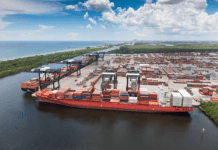
The upcoming break-up of the 2M alliance is going to lead to a change in the competitive makeup of the deep-sea networks, according to Sea-Intelligence.
More specifically, although the formal break-up will not happen until January 2025, gradual changes are likely to happen during the two-year transition period.
In the hypothetical case that the other two alliances remain intact, and that the orderbook gets delivered on time, the changes in the capacity market share with a ‘pure’ break-up of 2M on the Transpacific would look like the following graph.

“Before we go into that, however, the delivery of new vessels is not simply a matter of adding capacity onto a trade, as charter vessels will be returned, ageing vessels will be scrapped, etc. Depending on how these assumptions play out, the outcome can be drastically different,” commented Alan Murphy, CEO of Sea-Intelligence.
Thus, the Danish maritime data analysis firm has chosen to create a baseline based on the very simple assumption that carriers in general will take delivery of new vessels, and irrespective of the size of these vessels will internally cascade capacity between all their global trades, in such a way that the eventual outcome will be an even growth in capacity across their entire operated network.
Using this baseline, on the Transpacific as a whole, Maersk will be the smallest of the major carriers and alliances, and with an operated capacity matching the combined niche carriers in the trade.
MSC will be stronger positioned compared to Maersk, but it will, still, be slightly smaller than THE Alliance, and the Ocean Alliance which will be in an extremely strong position in the market, according to Sea-Intelligence report.
On Asia-Europe, the situation will be basically the same as on the Transpacific, with the only exception being that the small niche carriers play a very marginal role in this trade.





